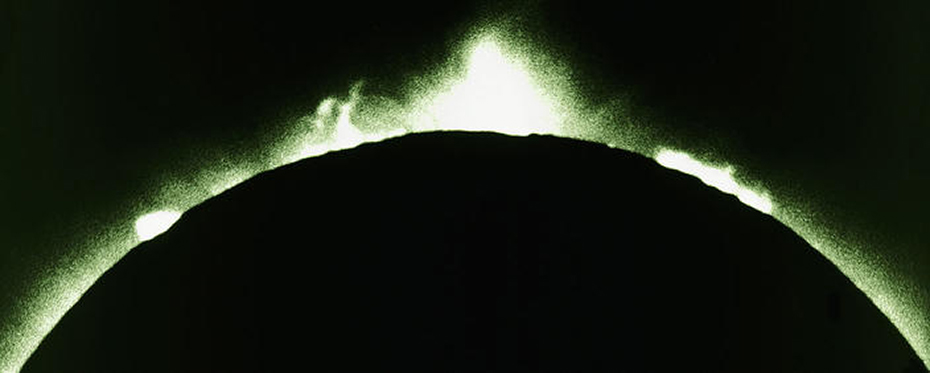The importance of solar eclipses
Prior to 1842, solar eclipse observations focused on recording the moon’s first and last contact with the sun. In the event of total cover, the beginning and end of the totality was also recorded. This data was used to determine the geographic coordinates of a place on the one hand and correct the orbits of the earth and the moon on the other. By comparing this with the data provided by the prediction of the solar eclipse, the calculating methods could be corrected and improved further. The solar eclipse on 8 July 1842 drew attention to phenomena that could only be observed if the sun is covered totally, namely prominences and the corona.
After observation with telescopes, photography and eventually spectroscopy revolutionised solar research and yielded new, surprising insights.
In the early twentieth century, solar eclipses gained a whole new significance: the confirmation of Albert Einstein's general theory of relativity.
In the meantime, solar eclipses have partly lost their scientific importance. Instruments developed since 1868 enable prominences to be observed even without solar eclipses. In 1930 Bernard Lyot began developing the coronagraph, a telescope that creates an artificial solar eclipse so the bright areas of the corona can be observed even in the absence of solar eclipses. And radio waves allowed the relativistic refraction of light to be verified, even on a bright day, without having to wait for a solar eclipse. However, this does not mean to say that solar eclipses are no more than a beautiful spectacle these days. Several research groups still use them to study variations in the sun's diameter, the sun’s atmosphere, the corona and much more.
The first successful image of the sun during a total solar eclipse was a daguerreotype taken on 28 July 1851. Although the inner corona and prominences were clearly visible, at the time science still relied heavily on telescope observations.
By the solar eclipse on 18 July 1860, photographic processes and cameras were already so advanced that the clear images taken by Angelo Secchi and Warren De la Rue enabled the prominences to be attributed to the sun.
Photographic images of the sun's corona during a total eclipse also helped study them in the twentieth century.
Jules Janssen travelled to the Indian subcontinent to observe the total solar eclipse on 18 August 1868 and, during its totality, noticed the bright hydrogen lines in a large prominence through his spectroscope. This gave him the idea that the latter would probably still be visible later on, too. Sure enough, he was delighted to see them flash in the spectroscope the following day.
The discovery of a new element
Independently of Janssen, at virtually the same time, Joseph Lockyer also succeeded in demonstrating that prominences could also be rendered visible at any time with the aid of the spectroscope. Lockyer analysed the spectrum of gases at the sun’s edge and discovered a yellow line, which he was unfamiliar with and did not seem to belong to any known element. He announced the discovery of a new element and called it helium. The gas was not detected in Earth until 1882 and obtained in the lab in 1895.
New information about the corona
On 7 August 1869, during a solar eclipse over the United States, Charles A. Young observed with the spectroscope a green line in the spectrum of the corona that also had to be an unknown element; he called it coronium. The new element was eventually identified as heavily ionised iron in 1941, which yielded key information about the corona: for such ionisation to be achieved, there has to be a temperature of 1 million degrees Celsius and a density smaller than the vacuum achievable in the lab.
Of all the key insights that the observation of solar eclipses has facilitated, the confirmation of Einstein’s general theory of relativity, or, more precisely, the refraction of light in the sun's gravitational field, is perhaps the most significant.
For the solar eclipse on 29 May 1919, the Royal Astronomical Society in London organised two expeditions led by Arthur Eddington: one to Sobral (Brazil), the other to the Principe Island (Gulf of Guinea). The objective: to determine the position of the stars in the area surrounding the masked sun. By comparing it with their position six months later, i.e. in the absence of the sun, the astronomers were able to conclude that the beam of light from the sun was deflected. The reading they obtained tallied almost exactly with the theoretical value of 1.75 arc seconds that Einstein had predicted with his General Theory of Relativity.
For the next fifty years, further tests followed with varying results. Then, in the 1970s, the value that Einstein had predicted was also confirmed almost exactly using radio waves, no longer needing total solar eclipses.
